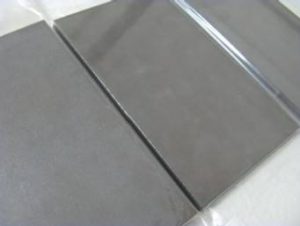Stanford Advanced Materials is devoted to machining standard backing plates and working together with the Taiwan Bonding Company for providing bonding services. For questions about target bonding materials, methods and services, please see our listing of frequently asked questions (FAQs).
○ Indium Target Bonding Service
○ Elastomeric Target Bonding Service

Metallic bonds provide good thermal and electrical conductivity and are recommended for most sputtering applications. Indium is the preferred method for bonding sputtering targets due to its high thermal conductivity and is the high efficiency at drawing heat away from targets. Indium is also more malleable than alternative bonding solders. The main limitation of an indium bond is the melting temperature of an indium solder. Indium has a melting point of 156.6°C, and temperatures over 150°C will cause the bond to melt and fail. Most materials can be indium bonded, however, there are a few exceptions. The elastomer is an alternative bonding method that touts a higher temperature capability over indium bonds. Elastomer bonds are recommended when customers are consistently melting indium bonds. Elastomer bonding is also suitable for low melting point target materials, temperature sensitive compounds and targets that have either low density or are especially fragile.
| Bond Material | Maximum Operating Temperature | Thermal Conductivity | Coefficient of Thermal Expansion | Electrical Resistivity (ohm-cm) | Bond Coverage | Bond Line Thickness | Target Size | Target Material |
|---|---|---|---|---|---|---|---|---|
| Indium | 150°C | 83 W/mK | 32.1 x 10-6 K-1 | 8 x 10-6 | >95% | 0.010″ ± 0.003″ | 1″, 2″, 3″, 4″, 5″, 6″, 7″, 8″ Diameter | Metal or Ceramic |
| Elastomer | 250°C | 54 W/mK | 2.2 x 10-4K-1 | 0.0476 | >98% | 0.010″ – 0.025″ | 1″, 2″, 3″, 4″, 5″, 6″, 7″, 8″ Diameter | Metal or Ceramic |
Our backing plates are from popular sputtering systems from OEMs, including Perkin-Elmer, MRC, and CVC, as is listed below. We also provide customized backing plates to fit any manufacturer’s cathode. Our in-house machining capabilities allow us to manufacture a full range of backing plates to original equipment specifications or custom cathode dimensions.
| Name | Type |
|---|---|
| Oxygen-free High Thermal Conductivity (OFHC) Copper Plate | Typical Material |
| Molybdenum Plate | Typical Material |
| Aluminum Plate | Typical Material |
| Stainless Steel Plate | Typical Material |
| Titanium Plate | Typical Material |
| Standard Copper Backing Plate for RF Magnetron | from Perkin-Elmer |
| Low-Carbon Iron & Copper Backing Plate for DC Magnetron | from Perkin-Elmer |
| Standard Copper Backing Plate with Removable Stainless Steel Studs | from MRC |
| Stainless Steel Backing Plate | from MRC |
| Enhanced Copper Backing Plate with Serpentine Water Cooling Track | from CVC |
A material can transfer heat through its thickness faster when the material is thinner. For most sputtering R&D guns, the thickness of the target is reduced to half when it is bonded to a backing plate because the gun has a maximum thickness allowance. The copper backing plate comprises the other half of the thickness. The thinner target can cool more effectively than a thicker target because the distance that the heat generated on the surface of the target has to travel to reach the cooling side is reduced.
A ceramic material can cool more efficiently when bonded. The target is in intimate contact with the conductive solder layer which draws the heat from the target surface and into the copper backing plate. The copper backing plate is in contact with the water cooled gun so the heat is transferred through both pieces of copper and is removed from the cooling water.
Some ceramic sputtering targets will crack during sputtering due to thermal shock regardless of whether the target is bonded or the ramping procedure used to condition the target. Bonded targets can usually continue to be used even after a target crack occurs, where typically an un-bonded target cannot.

To improve thermal conductivity under high power inputs, we offer target bonding on backing plates using indium-, elastomer-, aluminum- and silver-based metallic alloy. Durable target bonding requires a variety of pre and post bond functions to assure adhesion. Our quality bonding techniques and process are characterized as follows:
To eliminate cavities at the edges of a solder bond that may entrap air and form a virtual vacuum leak in your sputtering system.
To ensure the thermal integrity of the interface between the system’s cooling assembly and the surface of the target.
Zone controlled hot plates for precise control of thermal expansion and solderability.
C-Scan imaging system is used to detect material flaws, interrogate bonds and accurately measure thickness.
X-ray radiographic inspection to verify bond integrity.